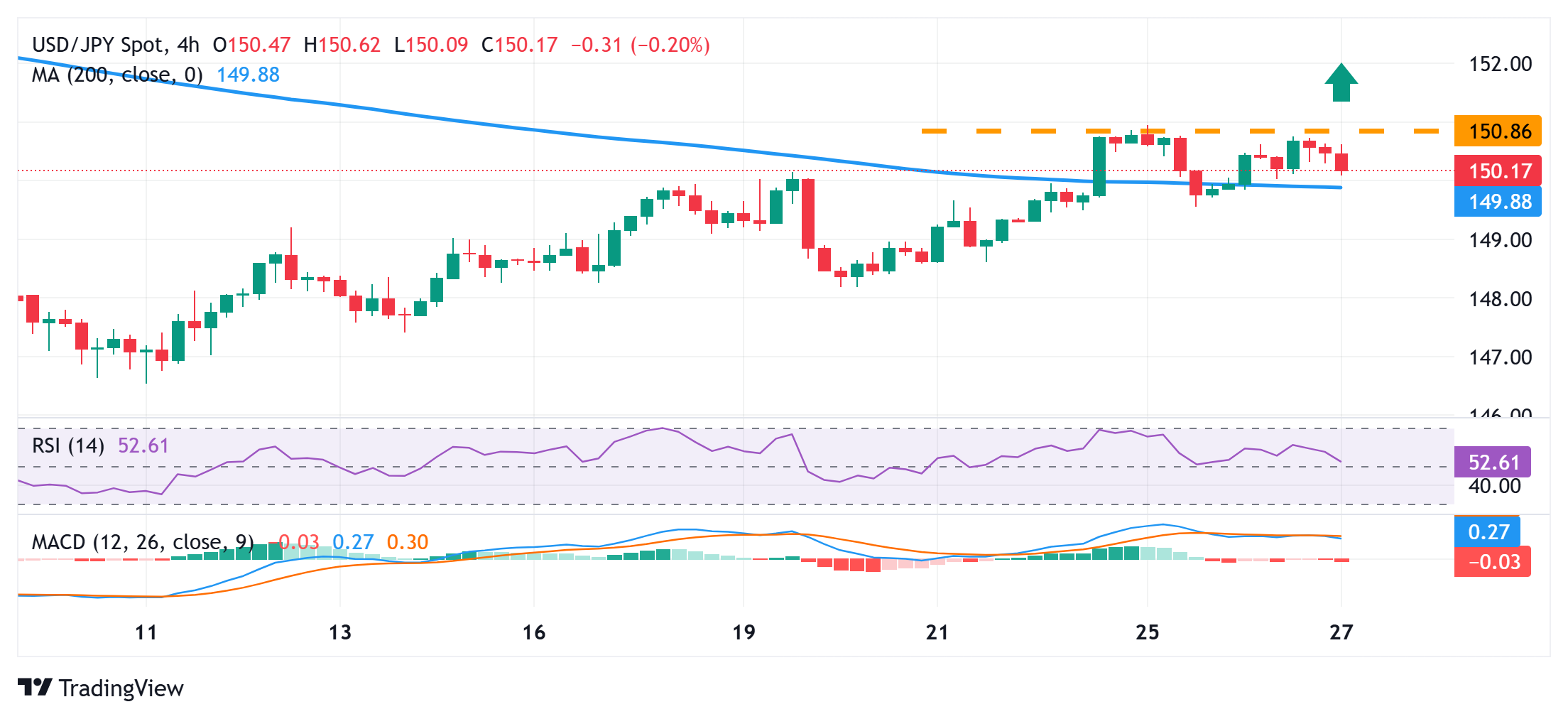Japanese Yen trims part of intraday gains against weaker USD; bullish bias remains
- The Japanese Yen struggles to capitalize on its modest intraday gains on Thursday.
- Hopes for more stimulus from China lift risk sentiment and weigh on the JPY.
- The divergent BoJ-Fed expectations should cap the upside for the USD/JPY pair.
The Japanese Yen (JPY) attracts some intraday sellers following an Asian session uptick as a slight improvement in the global risk sentiment, bolstered by hopes for more stimulus from China, undermines traditional safe-haven assets. However, the uncertainty over US President Donald Trump's tariff plans and their impact on the global economy might keep a lid on the optimism. Apart from this, the growing acceptance that the Bank of Japan (BoJ) will continue raising interest rates might continue to act as a tailwind for the safe-haven JPY.
Furthermore, the divergence between the BoJ and the Federal Reserve (Fed), which signaled that it would lower borrowing costs twice this year, should contribute to limiting the downside for the lower-yielding JPY. Adding to this, a modest US Dollar (USD) pullback from a three-week high keeps the USD/JPY pair in the red, below mid-150.00s. Traders might also opt to wait for the release of the Tokyo CPI and the US Personal Consumption Expenditure (PCE) Price Index on Friday. In the meantime, Thursday's US macro data could provide some impetus.
Japanese Yen bulls turn cautious amid an improvement in the risk sentiment; downside seems limited
- China’s Vice Premier Ding Xuexiang said earlier this Thursday that the government implement more pro-active macro policies this year and strive to achieve full-year growth target. Xuexiang added that improving trend in China’s economy has become more consolidated, though warned that there is a significant rise in uncertainties in the world.
- US President Donald Trump announced on Wednesday that he would impose 25% tariffs on all imported vehicles and foreign-made auto-parts on April 2, widening the global trade war. This comes on top of impending reciprocal tariffs against at least 15 countries next week and weighs on investors' sentiment, which is seen underpinning the safe-haven Japanese Yen.
- Investors seem convinced that the Bank of Japan will continue raising interest rates amid expectations that strong wage growth would underpin consumption and filter into broader inflation trends. Adding to this, BoJ's new board member Junko Koeda said on Wednesday that various indicators show underlying inflation moving towards 2% inflation sustainably.
- Meanwhile, the Federal Reserve revised its growth outlook downward amid the uncertainty over the impact of Trump's trade policies and signaled that it would deliver two 25-basis-points interest rate cuts by the end of this year. This fails to assist the US Dollar to capitalize on its recent move higher to a three-week high touched during the Asian session on Thursday.
- Chicago Fed President Austan Goolsbee said in a Financial Times (FT) interview on Wednesday that it may take longer than anticipated for the next rate cut to come because of economic uncertainty. Goolsbee, however, believed that borrowing costs would be a fair bit lower in 12-18 months from now, though wait and see is the correct approach.
- Separately, Minneapolis Fed President Neel Kashkari reiterated that “we've made a lot of progress bringing inflation down, still there is still more work to do.” Kashkari acknowledged that the job market has stayed strong and that policy uncertainty is complicating the Fed's job.
- St. Louis Fed President Alberto Musalem said that risks that inflation will stall above 2% or move higher in the near-term appear to have increased. If the labor market remains strong and second-round tariff effects become apparent, the US central bank may need to keep rates higher for longer or consider more restrictive policy, Musalem added further.
- The US Commerce Department reported on Wednesday that Durable Goods Orders rose 0.9% in February compared to the previous month's revised increase of 3.3%. Moreover, Core durable goods, which strip out the volatile transportation sector, increased by 0.7%. The readings were better than consensus estimates and provided a modest lift to the USD Index.
- Thursday's US economic docket features the release of the final Q4 GDP print, the usual Weekly Initial Jobless Claims data, and Pending Home Sales. The focus, however, will remain glued to the US Personal Consumption Expenditure (PCE) Price Index on Friday, which could provide some cues about the Fed's rate-cut path and influence the USD price dynamics.
USD/JPY needs to find acceptance above the 151.00 round figure for bulls to retain control in the near term

From a technical perspective, the USD/JPY pair's inability to build on the recent breakout momentum above the 200-period Simple Moving Average (SMA) on the 4-hour chart and failure near the 151.00 mark on Tuesday warrant caution for bulls. That said, oscillators on the daily chart have just started gaining positive traction and support prospects for the emergence of some dip-buyers. Hence, any further weakness below the 150.00 psychological mark could find some support near the 149.55 area. Some follow-through selling, however, could make spot prices vulnerable to accelerate the fall towards the 149.00 mark en route to the 148.75-148.70 support. The latter coincides with the 100-period SMA on the 4-hour chart, which if broken might shift the bias in favor of bearish traders.
On the flip side, any positive move beyond the 150.50-150.60 region might continue to face hurdle near the 151.00 mark. This is followed by the monthly swing low, around the 151.30 region, which if cleared will set the stage for an extension of the recent recovery from a multi-month low. The subsequent move-up should allow the USD/JPY pair to aim towards reclaiming the 152.00 round figure.
Risk sentiment FAQs
In the world of financial jargon the two widely used terms “risk-on” and “risk off'' refer to the level of risk that investors are willing to stomach during the period referenced. In a “risk-on” market, investors are optimistic about the future and more willing to buy risky assets. In a “risk-off” market investors start to ‘play it safe’ because they are worried about the future, and therefore buy less risky assets that are more certain of bringing a return, even if it is relatively modest.
Typically, during periods of “risk-on”, stock markets will rise, most commodities – except Gold – will also gain in value, since they benefit from a positive growth outlook. The currencies of nations that are heavy commodity exporters strengthen because of increased demand, and Cryptocurrencies rise. In a “risk-off” market, Bonds go up – especially major government Bonds – Gold shines, and safe-haven currencies such as the Japanese Yen, Swiss Franc and US Dollar all benefit.
The Australian Dollar (AUD), the Canadian Dollar (CAD), the New Zealand Dollar (NZD) and minor FX like the Ruble (RUB) and the South African Rand (ZAR), all tend to rise in markets that are “risk-on”. This is because the economies of these currencies are heavily reliant on commodity exports for growth, and commodities tend to rise in price during risk-on periods. This is because investors foresee greater demand for raw materials in the future due to heightened economic activity.
The major currencies that tend to rise during periods of “risk-off” are the US Dollar (USD), the Japanese Yen (JPY) and the Swiss Franc (CHF). The US Dollar, because it is the world’s reserve currency, and because in times of crisis investors buy US government debt, which is seen as safe because the largest economy in the world is unlikely to default. The Yen, from increased demand for Japanese government bonds, because a high proportion are held by domestic investors who are unlikely to dump them – even in a crisis. The Swiss Franc, because strict Swiss banking laws offer investors enhanced capital protection.
Forex News
Keep up with the financial markets, know what's happening and what is affecting the markets with our latest market updates. Analyze market movers, trends and build your trading strategies accordingly.
